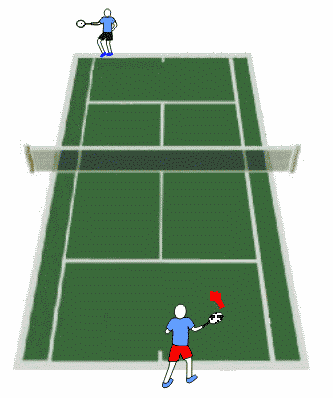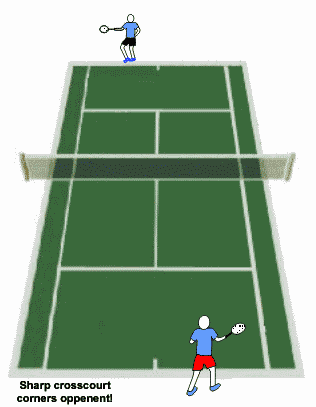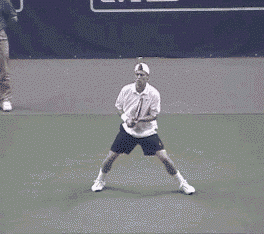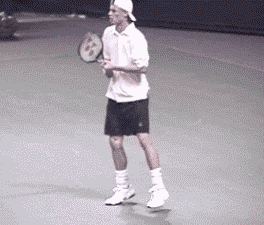<% ns_puts [mkm_getnavbar] %>
Lleyton Hewitt: Recovery Artist
by Jim McLennan
|
|
Lleyton Hewitt has risen to the top of his trade. With US Open and Wimbledon titles already under his belt, he plays with a ferocity some liken to a young Jimmy Connors.
Serves pretty good, ground strokes adequate, volleys rarely (he remarked that he did not serve and volley a single time in his recent Wimbledon conquest, more or less daring the others to beat him at the game he chooses to play) but oh can he move his feet.
Rarely out of position, quick as a cat to the ball, retrieving countless balls that would have been outright winners against less quick opponents.
When we look at footwork, whether professional or recreational, note there are three variations. There is movement to the ball, there is recovery movement back to the center of the court (actually the midline of the opponents angle of play) and there are adjusting steps to reposition on the court as the opponent’s positioning changes.
Players can be cat-like quick to the ball, cat-like quick to recover, or cat-like quick in all movements about the court. Hewitt is definitely in this latter category.
|
|
Moving to the Ball
Hewitt’s movement to the ball is extraordinarily quick. Let me elaborate. When trainers and coaches speak about movement on the court, they are generally referring to the power or speed of a player, and indeed, these trainers and coaches ask students to become more powerful in order to cover the court better.
Yet Hewitt appears quick not powerful, agile rather than muscular. Agility as defined by Webster is “moving quickly and easily” and for those interested in improving footwork, the key may be to focus on skills and drills that increase agility rather than power.
So, to observe Hewitt, first distinguish between balls that require little footwork, and those where he must quickly move a great distance to retrieve the ball. In the former instance, he uses either lateral sidesteps, or a crossover step. Hewitt generally plays the ball with an open stance, so in these instances sidestepping easily to the ball places him in an open stance position.
However, on the balls where Hewitt needs to cover a lot of court in a hurry, he relies a drop step – where he drops the foot nearest the ball as he turns placing him immediately in a running position.
So how does this effect the club player? I think when an athlete of
Hewitt’s skill uses the drop step for added quickness to difficult shots,
the same technique would help us mere mortals improve our agility about
the court as well.
as well.
As a teacher, I have noticed that club players who move easily and quickly often use the drop step (though in many instances it is instinctive rather than taught) and those who move slower generally are sidestepping when they should have been running. Again, the sidestep inhibits the running gait, the drop step or gravity turn instantly creates a dynamic running move.
Recovery footwork
Watching Hewitt defeat Jonas Bjorkman in the first round at Wimbledon I was fascinated by how often he was content to hit the ball perfectly down the middle of the court, and at other times by the acuteness of his cross court play.
Then it struck me, he creates angles of play that position him to the midline of the opponents reply, time and time again. And when positioned on this midline, it is nearly impossible to get a ball by him.
Generally, recovery footwork is passive, not active. In a center to center rally, after contact, Hewitt remains more or less near the baseline divider stripe, and at that spot he is on the mid-line of his opponent’s angle of play.
In a cross-court rally, after contact, he remains off center, not
recovering fully, as the opponent’s angle of play positions the midline
slightly off center. But in all these instances, the recovery occurs after the shot, and in response to the
location of the shot he has delivered across the net.
these instances, the recovery occurs after the shot, and in response to the
location of the shot he has delivered across the net.
Hewitt, I believe, is active in his recovery style. That is, he plans his shots in advance so they generally position him exactly on the subsequent midline. Again, his shot selection minimizes his recovery footwork; seemingly he chooses shots that require little if any recovery movement.
Watch him again, when he and his opponent are centered, he often goes right back down the middle, and in that instance moves not at all after his shot. In crosscourt exchanges, his angles are generally more acute than his opponents, this creates a situation where again he needs little if any recovery footwork steps.
Now when you reexamine his incredible movement about the court, notice
how well positioned he seems to be. And when superbly positioned, it takes
amazing shots to beat him. And with the exception of Agassi at the recent
US Open, rarely are we seeing player’s with the goods.
Your comments are welcome. Let us know what you think
about Jim McLennan's article by emailing
us here at TennisONE.
| Want to read more of Jim McLennan's unique insight into learning tennis? Check out his other original articles in the TennisONE Lesson Library. | |
|
Click here to order. |
The Secrets of World Class Footwork - Featuring Stefan Edberg
Pattern movements to the volleys, groundstrokes, and split step reactions. Rehearse explosive starts, gliding movements, and build your aerobic endurance. If you are serious about improving your tennis, footwork is the key.
29.95 |
To contact us, please email to: webmaster@tennisone.com
TennisONE is a registered trademark of TennisONE and SportsWeb ONE; Copyright 1995. All rights reserved.




